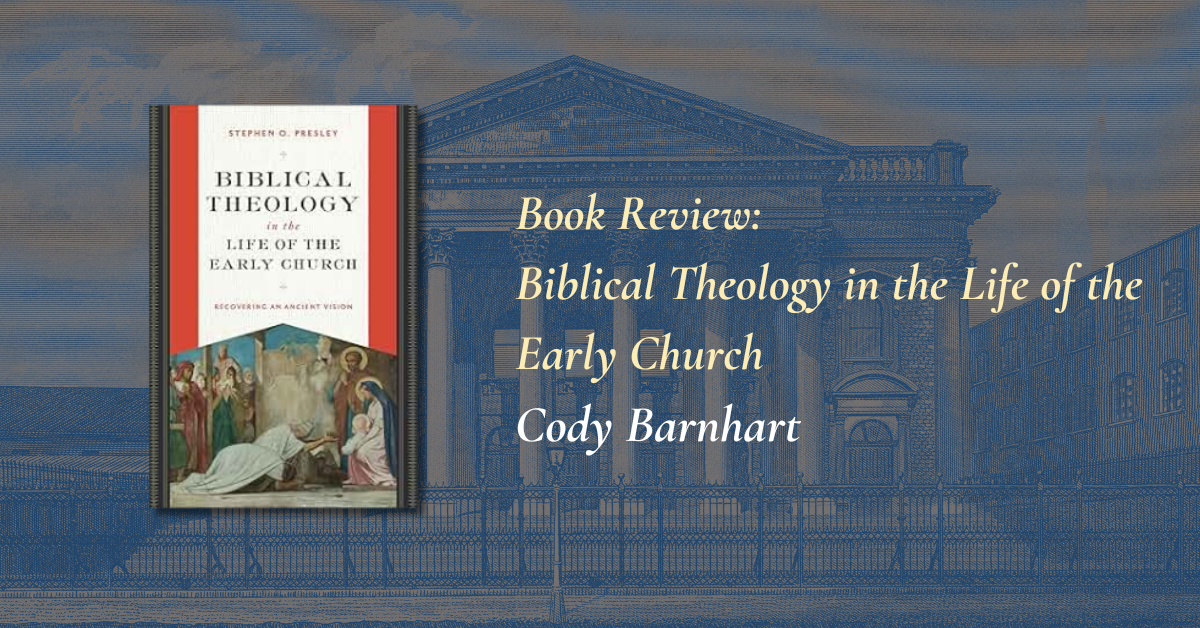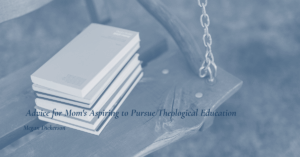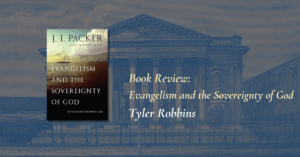The last decade or two has been replete with interest in the theology, exegesis, and reading strategies of the earliest Christians. Beyond the sheer increased scholarly interest in patristic exegesis and early Christian interpretation of Scripture, there has also been an uptick of interest among students, pastors, and lay leaders in studying premodern methods and frameworks with an aim of serving the church. Or, to put it another way, there has been much ado about theological retrieval.
Despite the hubbub, there have been substantially fewer examples of actually doing retrieval well. It is one thing to study church history and another thing to study hermeneutics, but to weave the two together in a meaningful and constructive fashion that serves the church is a bit of an artform. Often, attempts to do so are either overly concerned with the historical and not constructive enough (skewing toward the academic), or they are overly practical without handling the genuine historical nuances present in the Christian tradition. Stephen Presley’s Biblical Theology in the Life of the Early Church threads the needle nicely, offering a fresh and confessional analysis of early Christian hermeneutics. Throughout, Presley invites us to consider the usefulness of premodern approaches to biblical theological interpretation. By balancing academic rigor and contemporary concerns, Presley has winsomely confronted modern presuppositions with the premodern imagination, keeping the necessary evidence in tow as he recovers an ancient vision of biblical theology.
The book is organized into six chapters which by and large never feel overly bulky or unnecessarily lengthy. The book promises to “[bring] patristic biblical interpretation into conversation with contemporary biblical theology, exploring how assumptions and methods of figures such as Irenaeus and Augustine can guide modern hermeneutics.”1This is taken from the marketing copy (which authors admittedly sometimes have little control over). I thought it was an appropriate framing for the work, though, so I kept it here anecdotally. Overall, I think the book accomplishes this. Such a description highlights the work’s interdisciplinary and academic approach—and, commendably, Presley avoids both the overt overgeneralizations and common academic pitfalls of style common to these kinds of works. Presley explains the organization of the work in its introduction: the chapters “all work together, each one laying a new tile in the mosaic of early Christian interpretation” (10). As such, the book is best reviewed on the macro level, treating it as a whole and unified work. Presley does a good job maintaining continuity throughout the work, although this approach of forming a “mosaic” admittedly can make the book slightly more difficult for inattentive readers to follow. The content far outweighs any uncertainties this may raise, and Presley offers enough signposting to ensure his primary theses and lines of inquiry are clearly stated.
The first chapter (“Ecclesial Biblical Theology”) introduces the thematic textures and vocabulary the reader should expect to encounter throughout the rest of the work, casting “the general architecture of the fathers’ ecclesial biblical theology” (17). Rather than describing biblical interpretation as a rote method, Presley rebuilds the kind of cultural world which allowed patristic exegesis to flourish. In this initial chapter, Presley constructs this world by first laying a foundation upon the triumvirate of Scripture, the rule of faith, and liturgy. I found the chapter’s description of the rule of faith as an instance of what Charles Taylor has called a “social imaginary” particularly insightful (18–19). In framing the chapter through this lens, Presley makes a helpful and constructive move that models one way to accomplish theological retrieval. (And, indeed, I think I would agree the rule of faith becomes a social imaginary, making it an important piece in creating the mosaic that is patristic exegesis.) The chapter ultimately demonstrates that premodern biblical theology involves two main prongs: the threefold relationship between Scripture, the rule of faith, and liturgy, and the right ordering of these three things toward the proper end of beholding the glory of God.
The second chapter, “Signs of God,” offers a more detailed and topographical look at the use of the rule of faith in interpretation: “[The rule of faith] actively participates in the granular details of exegesis” (38). Presley utilizes the language of “signs” and their referents, arguing ultimately that “premodern interpretation assumes that the primary referents of Scripture, or the things to which Scripture points, are not merely material or phenomenological but spiritual” (39). This is, in his view, the definition of the “spiritual sense”—the “theological synthesis between text and referent” (39). I especially appreciate Presley’s intentional use of the term “spiritual sense” here and throughout much of the work. Many attempts to recover premodern (and especially medieval) exegesis have gotten so fixed on locating the quadriga that we seem to presume we may find it in every interpreter’s writing. It seems to me that “spiritual sense” is safer and most accurately capture the wide range of interpretative sensibilities that premodern writers hoped to tease out. Following his discussion of the spiritual sense, Presley offers several examples by articulating the “interpretive postures of biblical theology” (48–63). Through a swath of patristic authors, Presley shows how the fathers, too, agreed that “the signs of Scripture reveal to us the spiritual sense latent in the literal” (62–63).
In the third chapter, “Narratives of Scripture,” Presley discusses an important post-Enlightenment development: the death of the narrative. For the premoderns, “the story of Scripture is the substructure supporting the word of God in the world” (68). With some notable exceptions, however, Presley argues that many today struggle with a “modern fear of totalizing narrative” (70), which has trickled down from the rise of historical criticism and individualism in the nineteenth and twentieth centuries. Presley’s broader argument that modernity has succumbed to this death of the narrative is strengthened by his brief overview of Erich Auerbach’s work on the role of narrative in Homer and Moses (71).2I do wonder if this section of this chapter might, ironically, cause readers to miss the overarching narrative that Presley himself is trying to posit throughout the book. Still, it is important groundwork worth having in the work, and I’m not sure where else he could have placed it. While I think it may have been more compelling to offer engagement with ancient and modern literary sources that demonstrated the distinctions Presley hoped to make (rather than the secondary analysis of literary critics), Presley convincingly uses this section to demonstrate the importance of a grand metanarrative in the fathers’ interpretation of Scripture. As a consequence, he also implicitly demonstrates the ways the spiritual sense is intrinsic to the literal sense of Scripture, not placing the two at odds but rather understanding that they are two side of the same revelatory coin. He draws out three implications in his conclusion: the premodern impulse of narratival reading “situates the reader within the unfolding drama of salvation,” “is christologically conceived,” and “lays the intellectual and theological groundwork for specific intertextual connections such as typology, prophecy and fulfillment, or figural readings” (90–91). Overall, I think this chapter addresses important methodological concerns—something evangelical theologians seem to be increasingly allergic to today.
Chapter four, “Christ in All Things,” defends the very existence of the spiritual sense, both ontologically and in patristic literature. Largely, Presley does so by framing the nonliteral interpretation of Scripture as a practice of Christological exegesis. Again, I reiterate: I appreciate Presley’s care in doing this, and I especially appreciate the way he challenges the contemporary impulse to categorize every spiritual reading practice into specific techniques and assigning a value judgment to them. As he puts it, “Descriptors such as allegorical, typological, figural, tropological, and teleological are all subsumed under the spiritual sense, giving a variety of ways of conceiving of the spiritual sense” (98). Over against the common trope “typology = good; allegory = bad,” Presley shows how such flattened vision of patristic exegesis coincidentally imports more presumption onto ancient writings than fathers are accused of importing onto the text of Scripture. A better way, he contends, may be seen in three common readings strategies: personal, prophetic, and partitive modes of exegesis and interpretation (99–114). These three categories help represent some of the most prominent threads of patristic exegesis.
Perhaps, my favorite chapter of the book was chapter five, “The Good Life.” Plainly, Presley argues for the close relationship between virtue and the interpretation of Scripture in the ancient world. For ancient Christians, “the pursuit of virtue is indispensable throughout the whole process of interpretation” (123). In other words, interpreting sacred Scripture is not merely a philological task but an ethical one: it entails close attention to how God has revealed himself and should inform the transformation of the reader. Presley’s discussion of Origen’s reading of Numbers 33 is particularly stimulating. Origen likens the travels of the Israelites to the spiritual journeys of the faithful: “The travel narrative in Numbers shows that the journey of sanctification is not easy” (125). The development of virtue and the interpretation of Scripture are divergent questions but, rather, bound up with one another in a holistic sanctifying process of spiritual interpretation. Or, as Presley summarizes Henri de Lubac, “The sensus carnis (carnal sense) must decrease, so that the sensus spiritus (spiritual sense) increases and the whole person can perceive the Word of God” (129). Presley concludes the chapter by staging Augustine’s reading of Isaiah 11 (found in On Christian Doctrine1.10.10) into seven steps in cultivating virtuous interpretation of the Scriptures: fear of the Lord, piety, knowledge, fortitude, resolve, understanding, and wisdom. For Augustine, these culminate in a return to the third stage, with the skillful exegete undergoing this pedagogical journey on the path to true knowledge. While this may have pushed the work beyond the domain of biblical theology, I do wish there would have been more engagement demonstrating how these figures were drawing on and interacting with extant understandings of “virtue” in their discussion, particularly in the final section concerning “The Virtues for Reading,” where Presley surveys several figures’ definitions of the virtues. Perhaps, it would have been disruptive to the thread Presley was seeking to trace; it seems to me, however, this would have been an appropriate place to show continuities and discontinuities between “the philosophers” and early Christians on this point. Still, this chapter reemphasizes something important: the exegetical life is not primarily intellectual but spiritual. The interpreter of Scripture ought to be shaped by and affected by the philological journey of reading the Word. The cultivation of virtue is part and parcel of the Christian hermeneutic, and they cannot be divorced as many are so tempted to do in modernity.
The final main chapter, “The Community of Faith,” returns to the theme of the church’s place in forming biblical theology: “Good metaphysical commitments are not merely derived from rational reflection; they are handed down in the church’s Scriptures. Reading Scripture as about dwelling among the right community positions the reader in a place where the rule of faith is taught and the people of God unite in worship” (148). Wielding the fathers’ use of catechesis and liturgy, Presley demonstrates that the preceding reading practices did not take place in isolation but, instead, in the context of the community of faith. In terms of application, he argues that this aligns the task of biblical theology with the task of preaching: “Like two hands working together, interpretation and teaching are necessary and coordinate. The fathers cannot conceive of the act of biblical interpretation apart from edification and exhortation” (162–163). Thus, the Word of God is interpreted with an eye toward building up of the people of God to read Scripture to the glory of God: “We need to recover a thick ecclesiology that is infused with catechesis and liturgy, training the faithful to read Scripture well” (167).
By way of overall impressions, Biblical Theology in the Life of the Early Church is a well-researched and helpful primer for the contemporary Christian interested in understanding premodern readings of Scripture but not conversant with the relevant themes. Presley is a sharp reader of the Christian tradition and the corpora of early Christianity, and this strengthens the work immeasurably. He clearly does not merely cherry-pick or mine for quotes that support his purpose; still, his arguments are sound and textual. There are moments where the work feels perhaps too reliant on prominent secondary voices—Reno and O’Keefe, for example, come to mind as being cited gratuitously—but this is no doubt due in part to the difficult task of traversing the chasm between premodern and modern hermeneutics, and it rarely diminishes the value of the arguments Presley makes.
As a final word, I want to thank Presley for contending for theological retrieval by example. It is rare when a work so closely mirrors the scholar behind it, but such is the case here. The work’s helpfulness and rigor are outmatched only by the charity he exhibits as a reader of the fathers and as a scholar. I gladly recommend the work, and I thank Baker Academic for being willing to provide an advance copy to read while the book was still printing at the time of my request.
Author
-

Cody Glen Barnhart serves as Director of Music and Media at First Baptist Church of Alcoa, TN. He is a graduate of Midwestern College (B.A.). and presently is a Ph.D. candidate in early Christianity at the University of Aberdeen, where he studies Clement of Alexandria and how he contributed to early Christian theology. He is a lecturer at Johnson University.
View all posts




